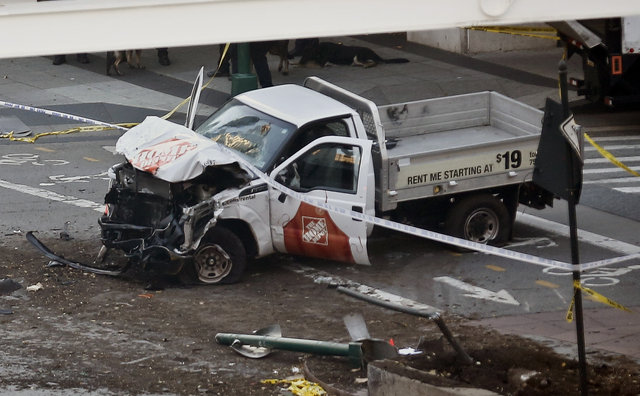Gothamist, November 2017
NYC Needs Radical Street Redesigns To Thwart Truck Terrorism, Experts Say
In light of Tuesday afternoon's deadly truck attack that killed eight people and injured twelve more, questions are being raised about how to prevent or at least mitigate the kinds of attacks that had until yesterday been seen largely in Europe but not America. With cars and trucks still a major facet of American life, some legislators, street safety advocates and urban design experts see street redesign and safety improvements as a major facet of counter-terror tactics.
After a driver plowed through a crowd of pedestrians in Times Square in May, which was not related to international terrorism but still took one life and injured almost two dozen people, Council Member Ydanis Rodriguez called for the installation of more metal bollards in front of schools, highly trafficked pedestrian areas and priority intersections. He introduced the bill in June, and it has since picked up 30 co-sponsors.
"What happened yesterday, what's happened in London and in other cities around the world, vehicles have been used as a weapon of mass destruction," Rodriguez, who is the chair of the council's Transportation Committee, told Gothamist. "For the 8.5 million residents, and the 60 million tourists who visited here last year, I believe we have to work faster to continue installing more pedestrian bollards."
On his bill itself, which is still in committee, Rodriguez said he's ready "to sit down with the administration to put together a plan to put this bill together as soon as possible."
"I believe if we're able to move a bill, agencies will have to make a plan to install bollards in all of those areas that are potential targets to terrorist attacks," Rodriguez said. "We know the only tools we have at this moment that can help us against a potential terror attack using vehicles as weapons of mass destruction, is by installing those bollards."
In Europe, bollards and other traffic barriers are widely seen as a way to prevent mass casualty attacks with cars and trucks.
According to Jon Coaffee, a professor of urban geography at the University of Warwick, the downside of relying on bollards exclusively as "design interventions" is you wind up with "a hyper-secure urban landscape that restricts movement and mobility and could... reduce quality of life and livability in the city."
"In many cases the placement of such obtrusive security, although understandable from a security point of view, has led to public concern about how such features will morph, over time, into large permanent steel structures that will reduce accessibility and freedom in public places," Coaffee said, citing protests against bollards in Melbourne, Australia and some Italian cities.
"In the longer term, if vehicle-restriction methods are deemed necessary, then it is imperative that we begin to think 'beyond bollards' and embrace effective urban designs that are less obtrusive and which have other co-benefits to the public realm — flower pots, benches, etc — but which still retain hostile vehicle mitigation functionality," Coaffee told Gothamist.
In a Washington Post article about street safety and counter-terrorism in June, Coaffee suggested "subtler design alterations" to road design. A redesigned road could potentially involve "small bends and turns" leading to a heavy pedestrian area to prevent a car from gaining speed, or even "a modern-day version of a ‘tiger trap’ to limit the movement of vehicles in certain areas by way of collapsible paving the gives way under a certain weight."
The Guardian also notes that "streets and access roads can be redesigned to prevent vehicles reaching targets or accelerating. This has been done throughout much of central London."
There's also the issue of the Hudson River Greenway itself. As far back as 2008, about a year after a drunk driver drove on to the bike/pedestrian path and killed cyclist Edward Ng, Transportation Alternatives noted there were eight crossings where drivers could easily enter the path. Saipov entered the bike path at one of those openings, West Houston Street.
Calling the use of cars as weapons "increasingly common," Transportation Alternatives' Caroline Samponaro called for major changes to the way the city deals with traffic and pedestrian safety.
In addition to bollards and granite blocks, Samponaro suggested that the city must do a better job of monitoring and managing car and truck traffic.
"With the very real threats that New York City faces, we must restrict vehicle access to New York City’s most vulnerable areas, such as Lower Manhattan and Midtown," she said in a statement. "More widely, the City of New York should begin regulating and limiting truck and vehicle access to our city’s most crowded areas the same way that many European cities do for both safety, security and street efficiency rationales. An obvious opportunity for improvement would be to move deliveries that require large trucks to overnight hours when streets are not teeming with pedestrians and cyclists."
While not specifically endorsing wholesale street redesign, Rodriguez said he thought the city "has been doing a great job" in terms of advancing street safety initiatives. "I support Governor Cuomo's proposal to have some type of congestion pricing. I believe that Midtown and other areas have been dealing with congestion and we have to work together to address that problem," he added. (Mayor de Blasio has repeatedly said he does not support congestion pricing, and recently said it did not "account for inequities.")
Ben Sarle, a spokesman for the de Blasio administration, said that the “NYPD, DOT and our State partners are closely conferring on installing safety bollards along the West Side bike path / Greenway as soon as possible."

